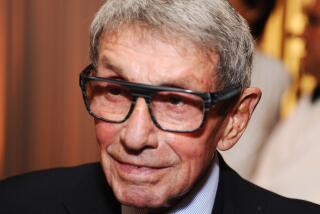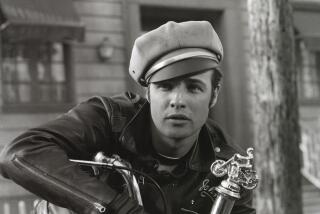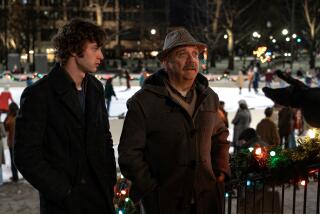At the Nuart, ‘Waterfront’ still packs a lusty punch
- Share via
It’s a sign of Marlon Brando’s gifts as an actor that his talent never used up all the air in the room. Brando was in fact a remarkable ensemble player, a skill he never used to greater effect than in “On the Waterfront,” now playing at the Nuart in West Los Angeles in a restored new print struck to mark the film’s 50th anniversary.
Yes, it’s been half a century since “Waterfront” won eight Academy Awards, including best actor for Brando, best supporting actress for Eva Marie Saint, best director for Elia Kazan, best screenplay for Budd Schulberg and best picture. One of its strongest elements, Leonard Bernstein’s only original feature score, was nominated but did not win.
Set and filmed on the docks of Hoboken, N.J., it’s a film whose McCarthy-era focus on the moral imperative of testifying before a government committee has always generated commentary.
But what is most striking today are its nonpolitical elements, the uniformly high quality of the acting and the genuinely touching nature of the romance between Brando’s agonized longshoreman, Terry Malloy, and Saint’s feisty neighborhood girl, Edie Doyle.
In addition to Brando and Saint, three other actors were nominated, all in the same supporting actor category, a first-time-ever tribute to Kazan’s legendary skill with performance. Still galvanizing are Lee J. Cobb as the self-named Johnny Friendly, the corrupt head of the longshoremen’s union, Karl Malden as the zealous waterfront priest, and Rod Steiger as Terry’s crooked brother, Charlie the Gent, “a butcher in a camel’s hair coat.”
Brando’s portrait of alternately cocky and agonized sensitivity seems closer to who the actor was than the strutting Stanley Kowalski of “A Streetcar Named Desire.” Brando completely inhabits the role of a man trapped by his own life, the play of emotions on his face as memorable as the iconic red and black plaid wool jacket he wears.
Saint, making her feature debut after having worked largely in television, matches Brando stride for stride in a fearless, firebrand performance. She stays with her costar even in their celebrated scene walking across a small park when, at ease in front of the camera as few actors have ever been, he improvises brilliantly with one of her unintentionally dropped gloves.
The other scene everyone remembers in “Waterfront,” the taxi conversation between brothers when Terry tells Charlie, “I could have been a contender, I could have been somebody, instead of a bum, which is what I am,” has lost nothing of its impact.
As Kazan himself adroitly summed it up in his autobiography, “It’s the one played over and over on TV until I got sick of it but never so often that I didn’t marvel at Brando and Steiger’s performances.”
As unspoiled in its key elements as the day it was made, “On the Waterfront” is indisputably one of the great American films, its power undiminished. Even more today than half a century ago, it demands to be seen.
More to Read
Only good movies
Get the Indie Focus newsletter, Mark Olsen's weekly guide to the world of cinema.
You may occasionally receive promotional content from the Los Angeles Times.








